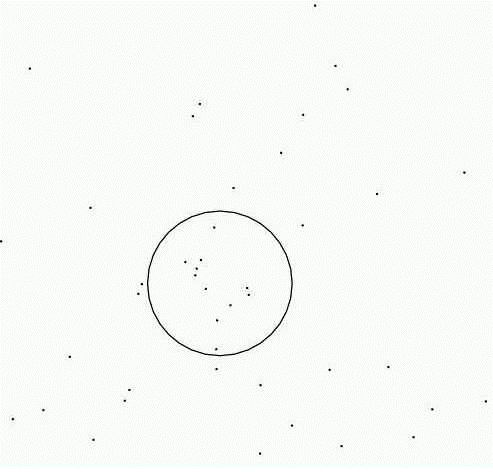地址:http://poj.org/problem?id=1981
题目:
Circle and Points
| Time Limit: 5000MS | Memory Limit: 30000K | |
| Total Submissions: 8198 | Accepted: 2924 | |
| Case Time Limit: 2000MS | ||
Description
You are given N points in the xy-plane. You have a circle of radius one and move it on the xy-plane, so as to enclose as many of the points as possible. Find how many points can be simultaneously enclosed at the maximum. A point is considered enclosed by a circle when it is inside or on the circle.

Fig 1. Circle and Points

Fig 1. Circle and Points
Input
The input consists of a series of data sets, followed by a single line only containing a single character '0', which indicates the end of the input. Each data set begins with a line containing an integer N, which indicates the number of points in the data set. It is followed by N lines describing the coordinates of the points. Each of the N lines has two decimal fractions X and Y, describing the x- and y-coordinates of a point, respectively. They are given with five digits after the decimal point.
You may assume 1 <= N <= 300, 0.0 <= X <= 10.0, and 0.0 <= Y <= 10.0. No two points are closer than 0.0001. No two points in a data set are approximately at a distance of 2.0. More precisely, for any two points in a data set, the distance d between the two never satisfies 1.9999 <= d <= 2.0001. Finally, no three points in a data set are simultaneously very close to a single circle of radius one. More precisely, let P1, P2, and P3 be any three points in a data set, and d1, d2, and d3 the distances from an arbitrarily selected point in the xy-plane to each of them respectively. Then it never simultaneously holds that 0.9999 <= di <= 1.0001 (i = 1, 2, 3).
You may assume 1 <= N <= 300, 0.0 <= X <= 10.0, and 0.0 <= Y <= 10.0. No two points are closer than 0.0001. No two points in a data set are approximately at a distance of 2.0. More precisely, for any two points in a data set, the distance d between the two never satisfies 1.9999 <= d <= 2.0001. Finally, no three points in a data set are simultaneously very close to a single circle of radius one. More precisely, let P1, P2, and P3 be any three points in a data set, and d1, d2, and d3 the distances from an arbitrarily selected point in the xy-plane to each of them respectively. Then it never simultaneously holds that 0.9999 <= di <= 1.0001 (i = 1, 2, 3).
Output
For each data set, print a single line containing the maximum number of points in the data set that can be simultaneously enclosed by a circle of radius one. No other characters including leading and trailing spaces should be printed.
Sample Input
3 6.47634 7.69628 5.16828 4.79915 6.69533 6.20378 6 7.15296 4.08328 6.50827 2.69466 5.91219 3.86661 5.29853 4.16097 6.10838 3.46039 6.34060 2.41599 8 7.90650 4.01746 4.10998 4.18354 4.67289 4.01887 6.33885 4.28388 4.98106 3.82728 5.12379 5.16473 7.84664 4.67693 4.02776 3.87990 20 6.65128 5.47490 6.42743 6.26189 6.35864 4.61611 6.59020 4.54228 4.43967 5.70059 4.38226 5.70536 5.50755 6.18163 7.41971 6.13668 6.71936 3.04496 5.61832 4.23857 5.99424 4.29328 5.60961 4.32998 6.82242 5.79683 5.44693 3.82724 6.70906 3.65736 7.89087 5.68000 6.23300 4.59530 5.92401 4.92329 6.24168 3.81389 6.22671 3.62210 0
Sample Output
2 5 5 11
Source
思路:
n^2logn的思路挺巧的,首先枚举每个点P,然后枚举其他点Q,算出以P为圆心和以Q为圆心的重叠部分,显然重叠部分最多的地方就是放圆心的最好位置。
求重叠次数是通过与两圆相交的交点构成的圆弧来判断的。
1 #include <iostream> 2 #include <cstdio> 3 #include <cmath> 4 #include <algorithm> 5 6 7 using namespace std; 8 const double PI = acos(-1.0); 9 const double eps = 1e-10; 10 11 /****************常用函数***************/ 12 //判断ta与tb的大小关系 13 int sgn( double ta, double tb) 14 { 15 if(fabs(ta-tb)<eps)return 0; 16 if(ta<tb) return -1; 17 return 1; 18 } 19 20 //点 21 class Point 22 { 23 public: 24 25 double x, y; 26 27 Point(){} 28 Point( double tx, double ty){ x = tx, y = ty;} 29 30 }; 31 32 /****************常用函数***************/ 33 34 //两点间距离的平方 35 double getdis2(const Point &st,const Point &se) 36 { 37 return (st.x - se.x) * (st.x - se.x) + (st.y - se.y) * (st.y - se.y); 38 } 39 //两点间距离 40 double getdis(const Point &st,const Point &se) 41 { 42 return sqrt((st.x - se.x) * (st.x - se.x) + (st.y - se.y) * (st.y - se.y)); 43 } 44 45 Point pt[500],pp[700]; 46 47 bool cmp(const Point &ta,const Point &tb) 48 { 49 return sgn(ta.x,tb.x)!=0?ta.x<tb.x:ta.y>tb.y; 50 } 51 int main(void) 52 { 53 //freopen("in.acm","r",stdin); 54 int n; 55 while(~scanf("%d",&n)&&n) 56 { 57 int ans=1; 58 for(int i=1;i<=n;i++) 59 scanf("%lf%lf",&pt[i].x,&pt[i].y); 60 for(int i=1;i<=n;i++) 61 { 62 int cnt=0,tot=1;; 63 for(int j=1;j<=n;j++) 64 if(i!=j) 65 { 66 double d = getdis(pt[i],pt[j]) / 2.0; 67 if(sgn(d,1)>0) continue; 68 double ag = atan2(pt[j].y-pt[i].y,pt[j].x-pt[i].x); 69 d = acos(d); 70 pp[cnt].x = ag - d, pp[cnt++].y = 1; 71 pp[cnt].x = ag + d, pp[cnt++].y = -1; 72 } 73 sort(pp,pp+cnt,cmp); 74 for(int j=0;j<cnt;j++) 75 if(pp[j].y>0) 76 ans=max(ans,++tot); 77 else 78 tot--; 79 } 80 printf("%d ",ans); 81 } 82 return 0; 83 }